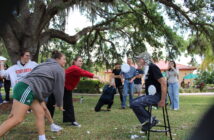In recent years, Florida high schools and colleges have slowly been implementing programs, such as Tobacco Free-Day, in an effort to make their school campus tobacco free. Some universities that have gone tobacco-free are the University of Tampa and Pasco-Hernando State College. Because of this, the Student Government Union (SGU) decided to push for Saint Leo to become a tobacco-free campus as well.
As part of the Tobacco-Free event held on Mar. 9, SGU set up tables around campus and encouraged students to take part in a quick survey featuring a variety of questions about smoking and tobacco use. Those students who participated received free Saint Leo beanies, shirts, and electric fans. SGU also will also be hosting an event with their partner, Gulfcoast North AHEC, and offering free classes at Saint Leo on tobacco usage and its effects on students and faculty. The event will be held on Mar. 20 and 22 in the SCC Boardrooms.
One of the largest benefits of having a tobacco-free campus is that students with asthma or lung cancer don’t have to worry about inhaling second-hand smoke. Senior Joshua Bantholomew, the president of the Student Government Union, commented about what he thought of Tobacco Free Day and what inspired him to do participate in the event:
“For the first time, it is actually good to see a student walk through the entrances of Lewis Hall and not worry about the smoking and leaving our campus as green as possible. I myself have asthma, and there are moments where I get dizzy when I get hit by secondhand smoking.”
For many people, second hand smoking can affect others in a variety of ways. Some may get dizzy, like Bantholomew, others may have a severe coughing fit. Everyone’s reaction is different. However, the effects of direct smoking do not vary from one person to another because the chemical compounds contained in cigarettes remain consistent. For instance, a smoker who smokes a cigarette a day inhales about 4,000 chemicals within their body every day, and only 43 of those chemicals could be a cancer-causing agent. Now compare this to the 7,000 chemicals that someone inhales through second-hand smoking, which contains about 70 cancer causing agents. These agents are harmful to the human body, but they are also highly addictive, making it difficult for many people to quit after they have started.
The SGU committee plans to start providing students services, such as therapy sessions, to help those who would like to try and quit. However, there are those who will argue that they might “be so addicted that they aren’t willing to quit.”





1 Comment
I could not refrain from commenting. Exceptionally well written!